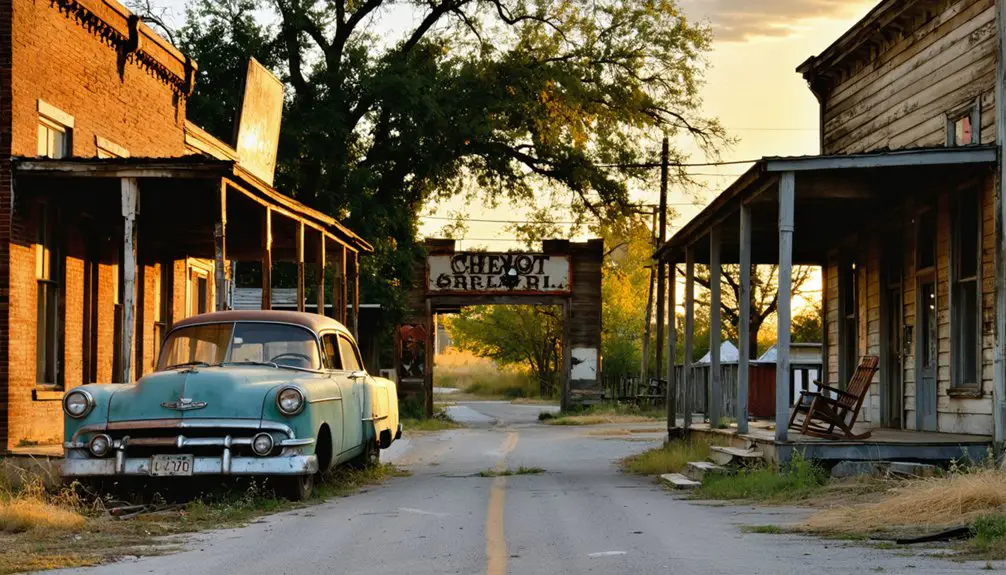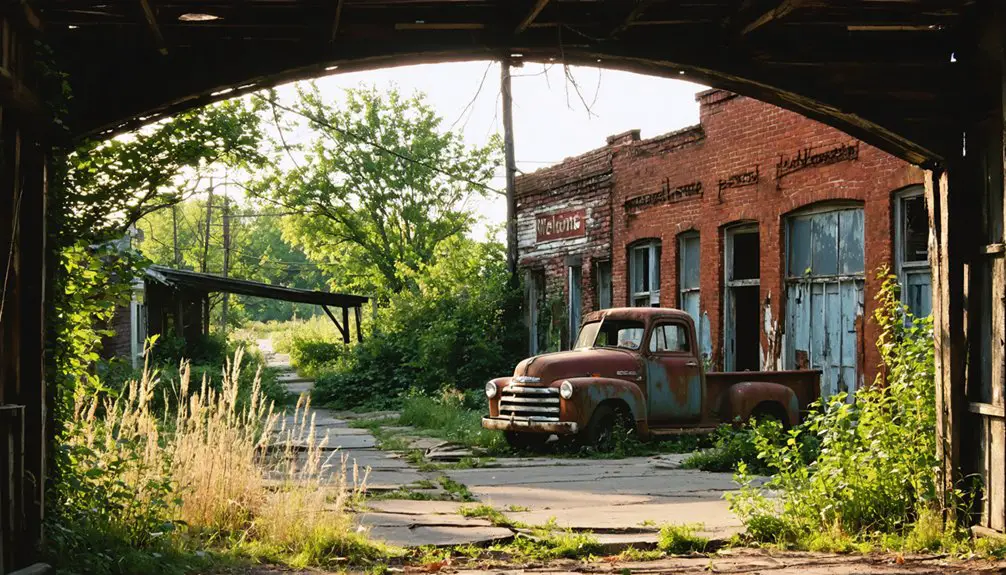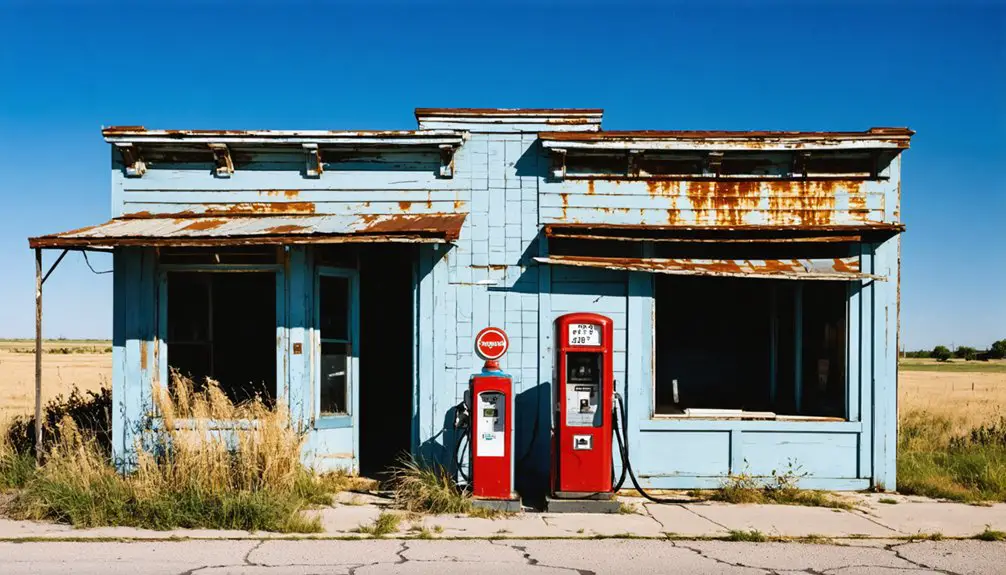You’ll find Welcome, Oklahoma among the state’s nearly 2,000 ghost towns, where empty streets and weathered buildings tell the story of a once-bustling railroad community from the early 1900s. Like many Oklahoma ghost towns, Welcome thrived during the railroad boom before declining as transportation routes changed and economic opportunities dwindled. Today, the town’s abandoned structures and quiet streets offer glimpses into Oklahoma’s dynamic past, with each crumbling storefront holding untold stories of frontier life.
Key Takeaways
- Welcome, Oklahoma was established during the railroad boom period but later declined as transportation routes changed and economic opportunities diminished.
- The town represents one of Oklahoma’s nearly 2,000 ghost towns, reflecting the state’s pattern of rapid growth and abandonment.
- Remaining structures in Welcome showcase the typical architectural style of early Oklahoma railroad towns during their peak period.
- Like many Oklahoma ghost towns, Welcome’s decline was marked by closure of essential services and exodus of residents.
- The site offers historical insight into Oklahoma’s transportation history and early 20th-century community development along railroad routes.
The Rise and Fall of Oklahoma’s Ghost Towns
While Oklahoma’s landscape today appears dotted with abandoned buildings and empty streets, these ghost towns once thrived as bustling communities shaped by the state’s dynamic history.
You’ll find nearly 2,000 ghost towns across Oklahoma, each telling a unique story of boom and bust.
These settlements emerged from various catalysts – railroad stops, mining operations, oil discoveries, and even “liquor towns” that strategically bordered dry territories. Towns offering alcohol to dry territories became especially prevalent along state borders during prohibition.
Natural disasters like devastating floods forced some communities like Burke City to completely abandon their original locations.
Many flourished along Route 66, only to fade when Interstate 40 diverted traffic elsewhere.
Others, like Picher, collapsed when mining resources depleted, leaving toxic remnants behind.
Today, ghost town tourism draws visitors seeking connections to Oklahoma’s past, while historical preservation efforts work to document these abandoned places before time claims their remaining structures.
Life in a Former Boomtown
You’ll find stark contrasts between Welcome’s bustling boomtown past and its quiet present, where abandoned buildings and deteriorating infrastructure tell the story of its former prosperity.
The challenges of daily life have shifted from managing rapid growth and oil wealth to basic survival needs, as remaining residents cope with limited services and aging facilities.
The town’s fading glory is evident in its scattered remnants of hastily built shops, homes, and industrial structures that once served a thriving population drawn by the promise of oil riches.
Children who played near the mining waste would often discover their hair turned orange from toxic exposure.
Disease outbreaks were common in the town’s heyday as workers endured cramped conditions where tuberculosis and diphtheria spread rapidly.
Daily Survival Challenges
Once-prosperous boomtowns across Oklahoma now face severe daily survival challenges as their populations dwindle and economies crumble.
You’ll find residents developing survival strategies like traveling long distances for basic necessities, healthcare, and education. In towns like Elmer, where the population plummeted from 300 to 40, you’re forced to adapt as banks, schools, and stores vanish.
Community resilience is tested by crumbling infrastructure, with abandoned buildings and limited emergency services complicating daily life. The town of Texola exemplifies this decline after Route 66 bypass led to widespread business closures. In Anadarko, the Indian capital status brings unique cultural heritage but hasn’t prevented economic decline.
You’ll encounter aging utilities, poor road maintenance, and limited internet access. Environmental hazards from former industrial sites, like toxic mining areas in Picher, create additional obstacles.
In places like Clayton, where 36.4% of residents live in poverty, you must navigate both economic hardship and diminished municipal services.
Former Glory Fades Away
The rapid decline of Oklahoma’s boomtowns stands in stark contrast to their former prosperity. You’ll find the economic shifts that transformed these once-thriving communities happened swiftly and decisively. When resources like oil dried up or railroads rerouted, the cultural impact rippled through every aspect of town life. Kusa Industrial newspaper chronicled the downfall of these ambitious settlements. Oil company names often lived on through abandoned town titles.
Businesses shuttered, families relocated, and the vibrant energy that once defined these communities vanished.
- Independent workers gave way to company employees, changing the social fabric that had created the initial boom atmosphere.
- Post offices, banks, and theaters closed as population numbers dwindled below sustainable levels.
- Environmental and industrial legacies, like those in Picher, replaced memories of prosperity.
You can still witness the skeletal remains of these towns today – decaying buildings and abandoned infrastructure that tell stories of ambitious dreams and swift decline.
Haunting Remnants of Yesterday
Scattered across Oklahoma’s landscape, ghost towns reveal their haunting past through weathered structures and forgotten ruins. You’ll find abandoned artifacts ranging from 1930s gas stations to territorial jails, each telling stories of boom-and-bust cycles that shaped these communities.
The toxic legacy of lead and zinc mining transformed once-vibrant towns like Picher into uninhabitable wastelands. The closure of rail service in the 1940s devastated towns like Kenton, accelerating their decline into ghost towns.
Collapsed roofs and vegetation-covered roads paint a portrait of places frozen in time.
Nature slowly reclaims these abandoned places, where crumbling structures stand like tombstones marking forgotten dreams and memories.
Cultural echoes linger in the remains of dance halls, saloons, and theaters with their unique “crying rooms.” These remnants whisper tales of outlaws, prohibition-era struggles, and the vibrant social life that once filled these spaces.
From submerged towns beneath man-made lakes to communities that have reverted to farmland, Oklahoma’s estimated 2,000 ghost towns stand as evidence of the transient nature of human settlement and economic fortune.
Lost Landmarks and Hidden History
You’ll find the ghostly ruins of Welcome’s landmarks scattered across the landscape – from the weathered stones of its pioneer cemetery to the abandoned church where hymns once echoed through wooden pews.
The skeletal remains of oil derricks stand as silent sentinels, marking spots where black gold once flowed freely during the town’s brief but vibrant boom period.
These deteriorating structures tell Welcome’s story of rapid growth and eventual decline, much like many of Oklahoma’s estimated 2,000 ghost towns that fell victim to changing economic fortunes.
Crumbling Churches and Cemeteries
Among Welcome’s most haunting remnants, crumbling churches and historic cemeteries stand as silent witnesses to the town’s vibrant past.
You’ll find weathered church architecture revealing decades of neglect, with metal roofs stripped by prairie winds and nature reclaiming what once served as the community’s spiritual center.
While the buildings decay, cemetery preservation efforts continue, maintaining these sacred grounds as enduring connections to Welcome’s earliest settlers.
- Methodist congregations often anchored these frontier communities, with their buildings serving as both religious and social gathering spaces.
- Despite widespread abandonment, many cemeteries remain well-maintained and active, with space reserved for future generations.
- Environmental factors and economic decline hastened the deterioration of church structures, though their cultural significance persists through historical documentation.
Oil Derricks Stand Silent
Rusting metal giants pierce Welcome’s horizon, proof of Oklahoma’s once-booming oil industry that began in 1859 near Salina.
You’ll find these silent sentinels reaching depths of up to 15,500 feet, remnants of advanced oil derrick technology that once pumped life into this ghost town economy.
Walking among these abandoned towers, you’re witnessing the aftermath of Oklahoma’s peak production era.
In 1927, these derricks helped produce 762,000 barrels daily, but by the 1980s, plummeting oil prices forced mass shutdowns.
The derricks extracted black gold from the rich Arbuckle Limestone and Wilcox Sand formations, with some wells initially flowing at 20,000 barrels per day.
Now they stand as weathered monuments to Welcome’s bygone prosperity, marking where fortunes were made and lost in Oklahoma’s oil frontier.
Tales From the Abandoned Streets

Walking through Oklahoma’s abandoned streets reveals the haunting remnants of once-bustling communities frozen in time.
You’ll find abandoned architecture telling stories of prosperity, lawlessness, and environmental disaster. Churches, schools, and gas stations stand as silent witnesses to historical shifts that transformed these towns from thriving centers to ghostly shells.
- Wind-swept buildings in towns like Texola showcase the impact of changing transportation routes, where Interstate 40’s arrival diverted crucial traffic from Route 66.
- Former whiskey towns dot the landscape, their empty storefronts evidence to the dramatic changes brought by Oklahoma’s 1907 statehood and dry laws.
- Historical preservation efforts now document these places where sudden depopulation left behind crumbling infrastructures, connecting you to Oklahoma’s frontier and boomtown heritage.
Preserving Oklahoma’s Ghost Town Legacy
Today’s efforts to preserve Oklahoma’s ghost towns reflect a complex web of historical documentation, cultural preservation, and community engagement. You’ll find academic projects, historical societies, and tribal nations working together to protect roughly 2,000 ghost towns across the state through detailed records and photographic archives.
The challenges you face in ghost town preservation extend beyond physical structures. You’re dealing with the intersection of tribal lands, cultural narratives, and environmental concerns.
Local communities contribute essential oral histories, while professional researchers compile extensive documentation from thousands of sources. You’re not just saving buildings – you’re preserving the stories of economic booms, railroad decisions, and community displacement that shaped Oklahoma’s landscape.
Each preservation project adds another layer to understanding these fascinating remnants of the past.
Modern-Day Ghost Town Adventures

While Oklahoma’s ghost towns stand as silent witnesses to the past, they offer modern adventurers a remarkable range of exploration opportunities.
You’ll find guided ghost tours in Guthrie’s historic district, where you can investigate paranormal stories while walking past haunted landmarks.
Throughout the state’s abandoned buildings, from Texola’s 1930 Magnolia Gas Station to Foss’s Route 66 relics, you’ll discover tangible connections to early 20th-century life.
Oklahoma’s forgotten structures serve as time capsules, preserving the raw spirit of early 1900s American life in their weathered walls.
- Experience chilling local legends on Guthrie’s Ghost Walk, with overnight stays available at the reportedly haunted Stone Lion Inn
- Photograph decaying architecture and empty streets in Texola, home to a historic 1910 Territorial Jail
- Explore Picher’s unique industrial landscape, where toxic remnants tell a compelling story of environmental impact (note: follow safety guidelines)
Frequently Asked Questions
Are There Any Surviving Buildings Suitable for Restoration in Welcome?
You’ll find limited information about specific surviving structures, though similar ghost towns suggest there’s restoration potential for any remaining buildings, though their architectural significance would need careful assessment before investment.
What Was the Peak Population of Welcome During Its Most Prosperous Years?
You can’t find exact peak population records for Welcome in ghost town history, but based on similar Oklahoma boom-bust patterns and population decline trends, it likely housed several hundred residents at most.
Did Welcome Have Its Own Newspaper or Local Publications During Operation?
Unlike towns with local journalism like Kusa’s *Industrial*, you won’t find historical records of Welcome having its own newspaper. The small settlement likely relied on neighboring towns’ publications for coverage.
What Natural Resources or Industries Originally Attracted Settlers to Welcome?
You’ll find that both agricultural opportunities and mineral extraction drew early settlers, with the region’s rich soil supporting farming while its proximity to lead and zinc mining districts offered industrial prospects.
When Was the Last Time Welcome Had an Active Post Office?
You’ll find Welcome’s post office history ended on June 15, 1926, though postal services operated under the name Alsuma after February 12, 1906, when they changed the original Welcome designation.
References
- https://en.wikipedia.org/wiki/List_of_ghost_towns_in_Oklahoma
- https://www.okhistory.org/publications/enc/entry?entry=GH002
- https://www.ghosttownsinoklahoma.com/post/ghosttownsinoklahomaintroduction
- https://okmag.com/blog/a-ghostly-site/
- https://www.youtube.com/watch?v=5XQUmVjjrZw
- https://www.youtube.com/watch?v=5d-wHDTIbb0
- https://www.okhistory.org/publications/ml/january2014.pdf
- https://www.youtube.com/watch?v=gg3ICLT5OZY
- https://nondoc.com/2022/01/04/whizbang-oklahoma-ghost-town/
- https://allthatsinteresting.com/picher-oklahoma



